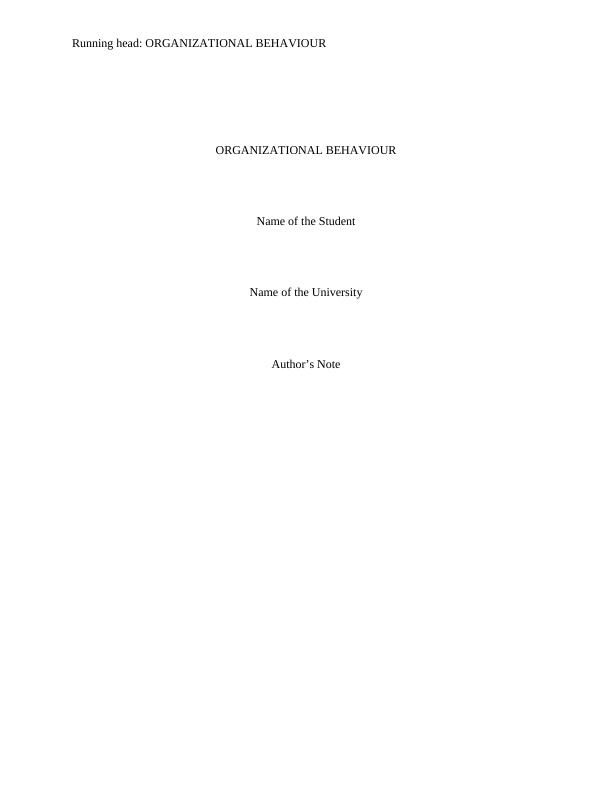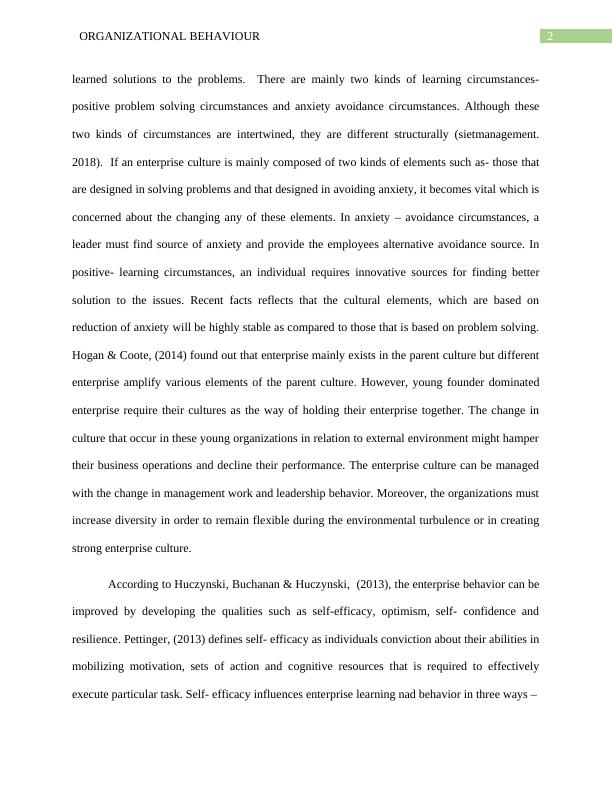Organizational Behaviour: Positive Culture, Leadership, Management Innovation and Organizational Size
Added on 2023-06-08
10 Pages2651 Words443 Views
Running head: ORGANIZATIONAL BEHAVIOUR
ORGANIZATIONAL BEHAVIOUR
Name of the Student
Name of the University
Author’s Note
ORGANIZATIONAL BEHAVIOUR
Name of the Student
Name of the University
Author’s Note

1ORGANIZATIONAL BEHAVIOUR
Introduction
The purpose of this essay is to provide an overview on the positive organizational
behavior, organizational culture and the moderating role of organization size in management
innovation. As the competition intensifies and pace of advanced technological change increases,
the organizations in today’s world renew themselves. This challenge not only offers new goods
and services but also changes the behavior, culture and management nature within the
organizations. Recent research findings reflect that self- efficacy, optimism, resilience and hope
plays vital role in maintaining positive behavior within the organization (Malik, 2013). In
addition to this, it has also been seen from recent studies that leadership behaviors also contribute
to the management innovation and change in the enterprise culture. The management innovation
and leadership also changed the organization and brought about potential benefits with the
emergence of new ideas. As management innovation mainly entails change in management
work, it leads to improvement in culture of the enterprise. This in turn also leads to positive
organization behavior, which includes pursuit of workers health and happiness. Overall, this
positive organization behavior and improvement in organization culture brought about by
management innovation leads to organizational excellence.
Article summary
Recent studies reflect that performance of the organization improves through change in
the organizational culture, positive organization behavior and innovation in management work
by influence of leadership behavior. The strength of enterprise culture is defined in form of-
stability and homogeneity of the group membership and intensity of the shared experience. ()
opines that if the enterprise has strong culture and has stable leadership, it can survive high
turnover rate at the lower ranks. Muscalu, (2014) states that the elements of culture is defined as
Introduction
The purpose of this essay is to provide an overview on the positive organizational
behavior, organizational culture and the moderating role of organization size in management
innovation. As the competition intensifies and pace of advanced technological change increases,
the organizations in today’s world renew themselves. This challenge not only offers new goods
and services but also changes the behavior, culture and management nature within the
organizations. Recent research findings reflect that self- efficacy, optimism, resilience and hope
plays vital role in maintaining positive behavior within the organization (Malik, 2013). In
addition to this, it has also been seen from recent studies that leadership behaviors also contribute
to the management innovation and change in the enterprise culture. The management innovation
and leadership also changed the organization and brought about potential benefits with the
emergence of new ideas. As management innovation mainly entails change in management
work, it leads to improvement in culture of the enterprise. This in turn also leads to positive
organization behavior, which includes pursuit of workers health and happiness. Overall, this
positive organization behavior and improvement in organization culture brought about by
management innovation leads to organizational excellence.
Article summary
Recent studies reflect that performance of the organization improves through change in
the organizational culture, positive organization behavior and innovation in management work
by influence of leadership behavior. The strength of enterprise culture is defined in form of-
stability and homogeneity of the group membership and intensity of the shared experience. ()
opines that if the enterprise has strong culture and has stable leadership, it can survive high
turnover rate at the lower ranks. Muscalu, (2014) states that the elements of culture is defined as

2ORGANIZATIONAL BEHAVIOUR
learned solutions to the problems. There are mainly two kinds of learning circumstances-
positive problem solving circumstances and anxiety avoidance circumstances. Although these
two kinds of circumstances are intertwined, they are different structurally (sietmanagement.
2018). If an enterprise culture is mainly composed of two kinds of elements such as- those that
are designed in solving problems and that designed in avoiding anxiety, it becomes vital which is
concerned about the changing any of these elements. In anxiety – avoidance circumstances, a
leader must find source of anxiety and provide the employees alternative avoidance source. In
positive- learning circumstances, an individual requires innovative sources for finding better
solution to the issues. Recent facts reflects that the cultural elements, which are based on
reduction of anxiety will be highly stable as compared to those that is based on problem solving.
Hogan & Coote, (2014) found out that enterprise mainly exists in the parent culture but different
enterprise amplify various elements of the parent culture. However, young founder dominated
enterprise require their cultures as the way of holding their enterprise together. The change in
culture that occur in these young organizations in relation to external environment might hamper
their business operations and decline their performance. The enterprise culture can be managed
with the change in management work and leadership behavior. Moreover, the organizations must
increase diversity in order to remain flexible during the environmental turbulence or in creating
strong enterprise culture.
According to Huczynski, Buchanan & Huczynski, (2013), the enterprise behavior can be
improved by developing the qualities such as self-efficacy, optimism, self- confidence and
resilience. Pettinger, (2013) defines self- efficacy as individuals conviction about their abilities in
mobilizing motivation, sets of action and cognitive resources that is required to effectively
execute particular task. Self- efficacy influences enterprise learning nad behavior in three ways –
learned solutions to the problems. There are mainly two kinds of learning circumstances-
positive problem solving circumstances and anxiety avoidance circumstances. Although these
two kinds of circumstances are intertwined, they are different structurally (sietmanagement.
2018). If an enterprise culture is mainly composed of two kinds of elements such as- those that
are designed in solving problems and that designed in avoiding anxiety, it becomes vital which is
concerned about the changing any of these elements. In anxiety – avoidance circumstances, a
leader must find source of anxiety and provide the employees alternative avoidance source. In
positive- learning circumstances, an individual requires innovative sources for finding better
solution to the issues. Recent facts reflects that the cultural elements, which are based on
reduction of anxiety will be highly stable as compared to those that is based on problem solving.
Hogan & Coote, (2014) found out that enterprise mainly exists in the parent culture but different
enterprise amplify various elements of the parent culture. However, young founder dominated
enterprise require their cultures as the way of holding their enterprise together. The change in
culture that occur in these young organizations in relation to external environment might hamper
their business operations and decline their performance. The enterprise culture can be managed
with the change in management work and leadership behavior. Moreover, the organizations must
increase diversity in order to remain flexible during the environmental turbulence or in creating
strong enterprise culture.
According to Huczynski, Buchanan & Huczynski, (2013), the enterprise behavior can be
improved by developing the qualities such as self-efficacy, optimism, self- confidence and
resilience. Pettinger, (2013) defines self- efficacy as individuals conviction about their abilities in
mobilizing motivation, sets of action and cognitive resources that is required to effectively
execute particular task. Self- efficacy influences enterprise learning nad behavior in three ways –

End of preview
Want to access all the pages? Upload your documents or become a member.
Related Documents
Organizational Behavior: Characteristics of Effective Change Leaderlg...
|6
|1513
|172
Analysis of Organizational Behavior Critiquelg...
|7
|1984
|33
Business Organizational Behavior : Assignmentlg...
|8
|2135
|91
Organizational Change Behaviorlg...
|9
|2251
|72
Organizational Behaviour Managementlg...
|4
|585
|22
Organizational Behavior: Types of Organizational Structure, Organizational Culture Theory, Innovation and Creativity, Learning Importance, Team Effectiveness, Change Managementlg...
|11
|557
|51